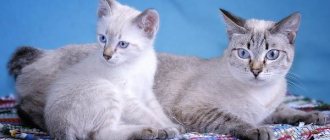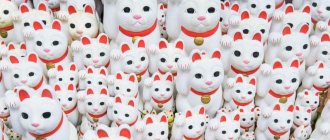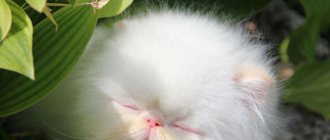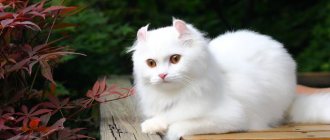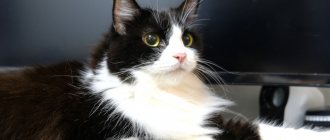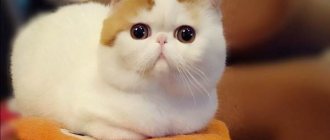When hearing the word “bobtail,” many people associate it with a dog. We tend to think that this is the name of the breed, although this term is used to refer to bobtail. And not only dogs, but also cats have this body structure. In any case, the Japanese Bobtail is one of the famous cat breeds, the representatives of which are distinguished by a short tail.
These cute creatures came to us from distant Japan and today live in the homes of many cat lovers. Easy care and playful character are advantages that any owner will definitely appreciate.
Origin story
The history of this breed goes back hundreds of years, and scientists still cannot say exactly where in the world these cats appeared. There is only an assumption that many centuries ago, clever mousecatchers arrived in Japan from China. However, initially their tails were the length familiar to those around them, and only much later, as a result of mixing of blood, did it shorten several times.
The superstitious Japanese only liked this change: they began not only to have bobtails in their homes, but also to depict them on canvas and sing them in poetry, and over time, these cats earned the highest imperial favor and ended up in the palace.
Bobtails were exported outside Japan only in 1967, when one of the breeders named Elizabeth Freret managed to buy and export three individuals to the American continent. A little later, several more animals were literally obtained through smuggling.
The standard was established in 1968, the same year the breed was registered with the CFA. But this only concerned individuals with short fur. Cats with a long “fur coat” were discarded for many years, until someone particularly meticulous, delving into ancient sources, found out that long-haired individuals were also kept at the emperor’s court and were valued no less than their counterparts. In 1990, they were also recognized.
Thinking about buying a Japanese Bobtail? You have a direct route to the nursery. Fortunately, it is in Russia: in the Moscow region, in the city of Zavidovo. On the territory of Belarus and Ukraine, alas, there are no nurseries or private breeders. The cost of an individual for a house from which there will be no offspring is approximately 30-40,000 rubles. Animals of a higher class will cost 2, 3 and even 4 times more expensive. But in Russia it is almost impossible to buy a show-class bobtail.
Cost of Japanese Bobtail
Sales are usually conducted through nurseries. Upon purchase, the owner receives all the documents, and the employees will talk about the intricacies of caring for the animal and show photos of the parents. Kittens living in nurseries are usually already vaccinated.
As for the cost, in Russia animals are valued at 15-35 thousand rubles for a pet-class pet. Kittens for breeding and exhibitions are more expensive. Unique kittens with different colored eyes cost up to 70 thousand. Abroad, the price of bobtails is 500-600 dollars.
Despite their ease of care and easy-going nature, bobtails require not only attention from the owner, but also a clear understanding that the animal needs to be looked after. Proper upbringing, a balanced diet and the creation of comfortable living conditions in the house - all this will help the Japanese Bobtail to remain cheerful and give a good mood to the owner.
Photo gallery of Japanese bobtails:
1111
Standards
| Standard | Description |
| Scull | Triangular, with clearly defined cheekbones and plump whisker pads on a funny oriental muzzle. |
| Nose | Medium length, with a pronounced “stop” on the bridge of the nose. |
| Eyes | Large, oval, wide open, set slightly askew. The color of the iris can be any. |
| Ears | Large and erect, densely pubescent on the inside. Small tassels may grow on the tips. |
| Torso | The body is long and rectangular. The muscles are visible, the general impression is that the cat is “lean”, gracefully built. The limbs are slender, long (the forelimbs are noticeably shorter than the hind limbs), arranged in the shape of the letter Z. The paws are oval and elastic. |
| Tail | Set high and curled into a ball. Its length in the straightened state is no more than 8 cm. The tails are conventionally divided into spiral and chrysanthemum-shaped. |
| Wool | The coat is thick and neat. Both short-haired and long-haired cats have very soft hair with no undercoat. In the area of the hind legs it grows thicker and more abundantly, forming lush pantaloons. |
Disqualifying signs:
- Strongly built body.
- Oval or round skull shape.
- A long tail.
- Small ears.
- Button nose.
Breeding
Since the breed is difficult to access in Russia due to the small number of nurseries, it is difficult to find individuals for breeding. Japanese bobtails are of interest to an increasing number of Russians, but it is difficult to find a purebred Japanese rarity in our country.
You can note the basic rules. Since the breed is not whimsical, it has no concessions in its range. But it should be remembered that it is still worth carrying out selection in order to obtain purebred offspring that will not only vaguely resemble a Japanese figure.
Important! If you cross a Japanese Bobtail with another breed, the offspring will have a standard tail.
The call to mating in this breed is not accompanied by heart-rending screams. Instead they make trouble. It is also worth noting that the bobtail itself is an excellent and caring mother.
3-4 kittens are born in one litter, the mortality rate of which is very low. When crossing a Japanese Bobtail with a long-tailed breed, offspring with a long tail are born.
Character and behavior
The Japanese Bobtail is a real little devil, whose unpredictability will not let you get bored for a single minute. On the one hand, he is a very affectionate and gentle domestic baby, a strong little one, who becomes attached to his owner with all his soul, on the other hand, he is an extremely independent and irrepressible cat-chieftain, who will not sit still for a second. Moreover, age has absolutely no effect on it: as a baby, as a teenager, as a mature cat, a bobtail will still jump, run and climb into all the nooks and crannies of the house, check packages and open closed drawers, poke its curious nose into pots and plates.
He can also sit next to his owner’s warm side, but for about five minutes, no more, and then he will return to his daily business - mischief and running around.
This is one of the most talkative breeds. He will tell you how bored he was while you were away, what he ate today, what bird he saw outside the window, or what a strange dream he had at night. You don’t have to answer him at all - the main thing for a bobtail is that they listen to him sincerely, and the rest worries him little. Therefore, weigh the pros and cons of this breed in advance.
The Japanese Bobtail has a great time with itself, so you can safely go to work or wherever you want. He will not refuse food during your absence or lie melancholy near the door; on the contrary, he will find a dozen interesting things to do and will be busy until your arrival.
Gets along well with other pets, and this applies to both dogs and other cats. Jealousy is alien to the bobtail, on the contrary: he will quickly be able to “talk” the second cat into joint pranks and become his best friend.
An intelligent and quick-witted bobtail grasps new information “on the fly” and lends itself well to training. Of course, only if he himself wants to learn something new. For example, doing a stand on your hind legs, or catching a foil ball on the fly. Walking on a leash can also be considered a trick - bobtails really don’t like it when their freedom is limited in any way. However, he needs to be leash trained if you want to take him outdoors.
Are a cat's pupils the same during the day and at night?
Not really
Mr. Cat recommends: Japanese Bobtail in art
People who are fond of watching anime know that the Japanese bobtail is often found in the frames of such cartoons. Moreover, it was this breed that became the prototype for the creation of the famous souvenir “maneki-neko” - a figurine in the form of a cat waving its paw.
This decoration for your home or office attracts good luck if the cat’s right paw is moving, or money if the cat’s left one is active. Often the Japanese themselves buy and give such souvenirs to company owners, and in stores this figurine stands in the most visible place so that they can earn good money.
These cats are often depicted on souvenirs or even product packaging, because the animal is beloved by the Japanese and encourages local residents to buy the product.
Care instructions
Japanese Bobtails are very clean themselves. They clean their skin several times a day, so not much effort is required from the owner.
Wool
Bobtails have minimal undercoat, so frequent brushing is not necessary. Once a week is enough. Bobtails' fur does not tangle or roll into tangles, the shedding process goes unnoticed, but the fur still requires careful handling and a special brush - with natural soft bristles.
Bathing
The process of bathing gives bobtails pleasure, and they are ready to get into a full bath at the first opportunity, but you should not indulge this desire. Frequent washing provokes irritation and dryness of the skin, rashes and peeling. Bathe your cat once every 4-5 months (and, of course, if he is so dirty that he cannot lick himself).
Choose special shampoos, without PVA, dyes and fragrances. The detergents Doctor ZOO, Pchelodar, Celandine, and “Deep Cleaning” from Cliny have proven themselves well: they are affordable, contain antibacterial additives, collagen and plant extracts.
Eyes
Dry eyes in bobtails are not the norm, but a signal of problems in the body, so do not delay going to the veterinary clinic. But discharge in the ears is not a sign of concern. Earwax should be removed weekly using a soft cotton swab dipped in boiled water or a special ear lotion.
Claws
Bobtails sharpen their claws themselves; all you need to do is buy several scratching posts and place them in all rooms. This will protect your decor from marks on the walls and furniture.
Teeth
Brushing your teeth is often difficult. A bobtail, due to its stubbornness, can begin to struggle and even hiss, which, however, is not even surprising: who would like it when they climb into his mouth with a hard brush and crawl back and forth? Therefore, try to accustom your pet to this procedure while still a kitten.
As a last resort, you can take your cat to the clinic for ultrasonic cleaning every year, and at home, drip a special cleansing gel into his water.
Toilet
Most often, it is not you who choose the litter for the tray, but your cat: if he is uncomfortable, he will definitely let you know. Keep in mind that for animals with sensitive paws, small round granules are needed, and for large cats you can buy larger ones (they will not get stuck between the toes or stick to the fur).
Buy only natural litter for kittens: babies can play too much and swallow several granules, which can cause stomach problems.
Bobtail dog
Under the shaggy coat of this dog lies a wayward, cheerful animal with persistence and innate herding instincts. The Old English Sheepdog or Bobtail loves people and is a good watchdog, although it is not a guard dog. The dog requires decent attention, especially in matters of grooming.
The first thing that catches your eye when meeting a bobtail dog is its amazing coat. Previously, these dogs were unreasonably considered stupid. In fact, the bobtail is an independent and intelligent animal. From an ordinary herding dog, the Old English Sheepdog has turned into an excellent companion dog that can help on the farm and brighten up the loneliness of any person. This is a very good-natured and active dog.
Many people describe the Old English Sheepdog as a kind, loyal pet that adores people. At the same time, sometimes the dog is distinguished by its stubbornness. Let's look at the main points that those who decide to become a bobtail owner need to know. The Old English Sheepdog has a fairly loud voice, but it is not a guard breed. Bobtail will be a great friend for children. He gets attached to people. To keep such a dog, you need to fence the yard with a high fence. Very often, shepherd dogs easily jump over small fences.
Early socialization of the dog is essential. This is of key importance in education and will prevent mistrust and aggression towards strangers. Some experts advise purchasing Old English Sheepdog puppies from breeders who raise puppies in their own homes. This is due to the fact that from birth the animal is among people and gets used to the appropriate atmosphere.
After purchasing a puppy, it is best to send it to a special class for training, but first consult with your veterinarian. Training from a professional will guarantee proper and effective education and training. The need for early training is primarily due to the fact that at this age puppies are completely controllable and make excellent contact. During training, you should reward your dog with praise and favorite treats. The most important thing in training an animal is patience and consistency.
Quite often the Old English Sheepdog is compared to a yard dog. The reason for this is her active behavior. The herding instincts inherent in this breed are the reason for the animal's activity. That is why the surrounding area should be securely fenced. This does not mean that the pet should be kept outside. When the family is at home, the dog should be with you. Lack of attention towards your pet can cause aggression and stress.
The distinctive feature of any Old English Sheepdog is its coat. This is also the most difficult part of caring for a dog. The thick and long coat will require weekly brushing from the owner, so be prepared to spend half an hour to an hour weekly. If you want your bobtail to take part in exhibitions, then the coat requires daily care! The disadvantage of this breed is
possible wool on carpets and furniture, however, with sufficient care such troubles can be avoided.
How much does a bobtail puppy cost?
Bobtail price:
- minimum price: $800.00
- maximum price: $1200.00
- average price: $1088.89
Video
Catering
Japanese Bobtails do not need to prepare special dishes: the standard cat menu is quite suitable. Moreover, experienced breeders recommend natural nutrition. What does it include?
Natural products
- Lean meats: lamb, chicken, turkey, veal, beef. Pork and other fatty varieties are too heavy on the stomach and often contain parasites. Meat can be given boiled, but it is better to scald fresh meat with boiling water and cut into small pieces: this way, more nutrients will be retained in the product.
- By-products: necks, ventricles, kidneys, liver. Everything except liver can be given raw. Be sure to beat the chicken necks with a hammer and run through a meat grinder.
- Porridge: oatmeal, pearl barley, buckwheat, semolina, rice, millet. Porridge is cooked in water; you can add just a little milk (for taste). Kittens at 2-3 months can be supplemented with semolina porridge cooked in goat's milk with a drop of honey.
- Vegetables: pumpkin, zucchini, carrots, broccoli, green salad, green peas, white cabbage, parsley, dill, cucumbers. They can be given raw (although rarely do cats like to eat raw vegetables), but it is better to be stewed and boiled.
- Dairy products: curdled milk, cream, sour cream, cottage cheese, cheese (unsalted and hard), fermented baked milk, bio-yogurt without dyes and berries.
- Eggs: quail and chicken. Quail can be given whole, but from chicken - only the yolk.
- Fish and seafood. Fish of the salmon family (chum salmon, pink salmon, coho salmon, salmon, taimen, grayling, gole, omul, whitefish) are considered the most healthy. From seafood, rapana, squid, mussels, lobsters, lobsters, shrimp, crabs, crayfish are allowed - but only as a delicacy. All of the above is either frozen or boiled.
- Vitamins: your veterinarian will help you choose the appropriate complex. You can buy dry yeast yourself (the instructions are included in the package and are clear).
You cannot give:
- Bones. Even small and boiled ones can damage the throat, esophagus and stomach, pierce or scratch the mucous membrane and cause inflammation.
- Offal, lard, skin.
- Sweet, salty, smoked, pickled, sour, flour, baked goods.
- Potatoes, tomatoes, avocados, grapes, bananas.
- Sauces, pastes, mayonnaise, seasonings.
- Food for dogs and birds, human vitamins.
- Alcoholic drinks, mineral and carbonated water, juices, fruit drinks, cocktails.
Recommended food
If it is more convenient for you to feed your pet industrial food, choose only proven food from the holistic group. They are not cheap, but they are made from high-quality products, go through all the necessary processing and do not contain components that can negatively affect the cat's health.
Acana, Go Natural, Primordial are examples of good holistic foods. Super-premium foods may contain allergens such as cornmeal or potatoes, but overall they are a good alternative. This food is Guabi Natural, Meowing Heads, ProSeries.
Below are the recommended holistic and super-premium foods. Links with the names of the food are clickable, on them you can, within our website, get acquainted with the descriptions of the food and read reviews from owners of Japanese Bobtail cats.
| Holistic | Super premium | Super premium |
| Farmina N&D | Brit Care | Natyka |
Adult animals (over a year old) eat 2 times a day. An exception is made for pregnant and lactating cats - they are fed 3 times a day. Cats from six months to a year eat 3 times a day, at 4-6 months - 4 times, under 4 - 5-6 times.
Expert opinion
Dusheba Vera Ivanovna
In 2010, she graduated from the Moscow State Academy of Veterinary Medicine named after K.I. Scriabin with honors, specializing in veterinary medicine. I regularly attend veterinary conferences, congresses, and webinars.
Whatever the food - dry food or natural food - the animal must have access to clean drinking water at any time of the day. You should not give your cat boiled water; it is better to give it raw, but always purified. Purify the liquid using a filter (the usual one that is in your kitchen), settling (in a saucepan or jar without a lid for 10-12 hours) or buying bottled water in the store. Change the water 2 times a day: morning and evening, and also when dirty.
Bowls are washed after each meal - this applies to natural feeding. Dry food does not stain dishes as much, so it is enough to rinse them 3-4 times a week.
Maintenance of the Japanese Bobtail: nutrition
You can use artificial or natural food. The latter must include:
- sea fish;
- low fat beef;
- dairy products;
- liver and other offal.
Taking vitamin complexes is mandatory. You will also need to monitor your weight. It is better to stick to the norm of 80 kcal per 1 kg of body weight. Although representatives of this breed are generally not prone to obesity due to constant activity (with the exception of castration and sterilization).
Among brands of artificial food, premium options are recommended - usually such manufacturers have a wide range of products, which allows you to choose an option depending on the age and other characteristics of the cat.
It is also necessary to constantly monitor the availability of water for the animal, because cats of this breed are active and often want to drink.
Diseases
Since this is a native breed, no genetic pathologies have been identified in them. There are no claims to immunity either.
The only caveat: due to the lack of undercoat, bobtails easily catch colds. Therefore, make sure that there are no drafts in the apartment, let the cat dry thoroughly after water treatments, and also, do not allow the animal, hot after playing, to sit under the open window.
Everything else is standard. Helminths need to be driven out even if your cat does not go outside. These parasitic worms can live not only in the soil or other people's excrement, but also remain on raw meat, fish, and you can bring them into the house on your own hands or shoes. They are easy for humans to become infected with, so remember: Pirantel, Kanikvantel, Troncil K, Prazitel have proven themselves well in the pharmaceutical market. They can be given to a kitten from 3 months. A year - 4 times, if the cat stays at home, more often for street cats. After 2 weeks, cats can be vaccinated.
Expert opinion
Dusheba Vera Ivanovna
In 2010, she graduated from the Moscow State Academy of Veterinary Medicine named after K.I. Scriabin with honors, specializing in veterinary medicine. I regularly attend veterinary conferences, congresses, and webinars.
Cats nursing babies, as well as pregnant cats, should not be given medications! You should be more careful with cats that are elderly, weakened after illness, or exhausted. To be sure that you do not harm your pet, consult your doctor first. The veterinarian will examine the animal, take the necessary tests, and possibly prescribe additional tests.
Health
The average life expectancy varies from 13 to 15 years, but long-livers of 20 years of age are not uncommon.
This breed is considered generally healthy, with only occasional skeletal defects in kittens. The short tail of the Japanese Bobtail is a genetic mutation, but does not carry with it any other defects or mutations.
One of the characteristics of kittens is their different eye colors, namely one is blue and the other is yellow. This is mainly characteristic of individuals with white coat color. Such a kitten is more likely to be deaf.
Advantages and disadvantages
- Beautiful in appearance.
- Loyal to their owners.
- They are smart and quickly grasp new information.
- They do not require complex care.
- They love to swim.
- They practically do not shed.
- They respond well to training.
- They have excellent health and no genetic diseases.
- They live long.
- They quickly get used to their new place of residence.
- They love walks in nature.
- Their tail is a point of increased attention.
- Activity can be tiring for those around you.
- They can be extremely stubborn and persistent.
- Excessive curiosity can lead to disaster.
- They are sensitive to temperature changes and freeze easily.
Interesting Facts
- An image of these cats is located in the Japanese Gotokuju Temple. Often, she is depicted with one paw raised, indicating a greeting, which is why you can see such a figurine at the entrances to Japanese houses or shops. Thus welcoming everyone who comes.
- According to scientists, Japanese bobtails have the development of a three-year-old child and perfectly understand what a person says.
- The Japanese believed that cats of this species exude positive emotions. Cats of the “mi-ke” coloring enjoyed a special privilege.
- If it is believed that cats came across the Japanese border after World War II, when soldiers from the United States began to take them to their country.
Castration and sterilization
To preserve breed characteristics, only animals that strictly comply with all exterior standards are allowed for breeding work. All others need to be castrated or sterilized to avoid unwanted matings. Recommended age limits for sterilization or castration surgery:
- cats - after 10 months;
- cats - at 8–12 months (it is better to carry out all surgical procedures before two years).
These operations can be done from three months until old age. But early castration or sterilization can cause delays in the development and growth of the animal. And the older the pet, the more difficult it is for him to tolerate surgery and anesthesia.
Caring for your pet after surgery
Caring for your pet after surgery is easy. The following conditions must be met:
- to prevent the seams from licking, a special blanket or collar is put on the cat;
- once a day, the blanket is removed, and the seams are treated with disinfectants (chlorhexidine solution, hydrogen peroxide, etc.);
- limit the animal’s activity for several days (so that the stitches do not come apart);
- do not feed for 8–10 hours;
- protect from excessive noise and disturbance;
- if the pet is worried and it is clear that he is experiencing pain, then he is given painkillers (Ketofen, Pervicox, etc.), but only a veterinarian prescribes the dosage.
To prevent the cat from licking the stitches, a post-operative collar or blanket is put on it.
You should immediately seek advice from a veterinary clinic if there are any suspicious symptoms: the cat refuses food for more than three days, the sutures are swollen and wet, etc.
